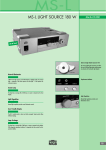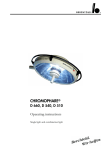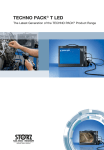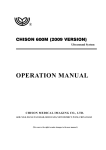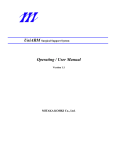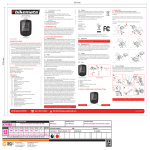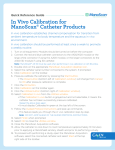Download Instruction for Use - Gastrointestinal Measurments - 1
Transcript
Instructions for Use PROBE 409 for Gastrointestinal Measurements Intended use: This instruction is a brief description of how to perform gastrointestinal measurements of mucosal blood perfusion using laser Doppler. Equipment: PROBE 409 (∅ 1.7mm or 2.5 mm) PeriFlux System 5000 equipped with PF5010 Laser Doppler Perfusion Monitor. PC with PeriSoft for Windows To be used with: Endoscopic equipment (not supplied by Perimed) Instructions 1. Check calibration of the laser Doppler probe. 2. Set up the PeriFlux System 5000 and the computer side by side so that the physician can follow both the laser Doppler signal and the endoscope image at the same time. 3. Feed the probe through the biopsy channel of the endoscope until approximately 10 mm sticks out at the other end. Note! PROBE 409 is available in two diameters: 1.7 mm or 2.5 mm. Choose the diameter that, together with the endoscope, allows for best manipulation and control of the probe. 4. Introduce the endoscope into the patient and start recording, see Figure 1. The inherent movements of the gastrointestinal tract can make laser Doppler measurements difficult to carry out. During measurements, consider the following: Press the probe tip against the mucosal wall firmly to keep it in place, but avoid strong pressure that can interfere with the local blood perfusion. Make measurements at several different sites to facilitate data evaluation. Breathing artefacts can be reduced by asking the patient to hold his/her breath for short periods of time during recording. Figure 1: PROBE 409 resting against the intestinal mucosa. In addition to the laser Doppler signal, also record the TB parameter (Total amount of Backscattered light). The TB value should be stable. A fluctuating value is an indication that the probe is not resting properly against the tissue. Note! Checking the light source of the endoscope. Remember to check the light source of the endoscope. The light source should have a wave length below that of the Perimed laser (780 nm for PeriFlux System 5000), otherwise there is risk for light interference. Select green light on the endoscope, if available. Perimed AB, Box 564, SE-175 26 Järfälla, Stockholm, Sweden Tel: +46-8-580 119 90 Fax: +46-8-580 100 28 E-mail: [email protected] Websites: http://www.perimed.se and http://www.tcpo2.com Part no. 44-00151-01 Instructions for Use PROBE 409 for Gastrointestinal Measurements Example Recording A typical output from laser Doppler measurements in the gastrointestinal tract is shown in Figure 2. Good measurements were obtained in the areas highlighted in blue. During these intervals, the patient was holding her breath to avoid breathing artefacts. In addition, the stable TB value indicates that the probe was resting properly against the tissue. In the remaining area, movement and breathing artefacts can be observed. Breathing artefacts Movement artefacts Variable TB values Figure 2: A typical output from laser Doppler measurements in the gastrointestinal tract. For more information. For more information, please refer to the PeriFlux System 5000 Extended User Manual and PeriSoft for Windows Extended User Manual, or contact Perimed AB or your local representative. Visit the Perimed homepage at http://www.perimed.se or http://www.tcpO2.com. Perimed AB, Box 564, SE-175 26 Järfälla, Stockholm, Sweden Tel: +46-8-580 119 90 Fax: +46-8-580 100 28 E-mail: [email protected] Websites: http://www.perimed.se and http://www.tcpo2.com Part no. 44-00151-01


